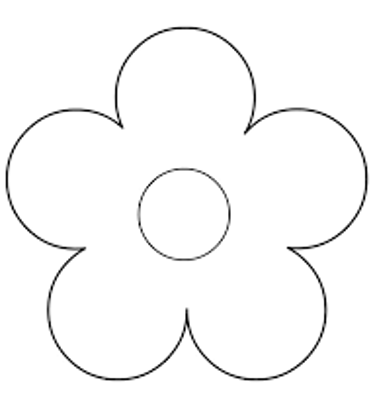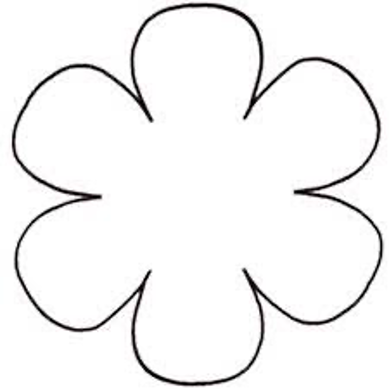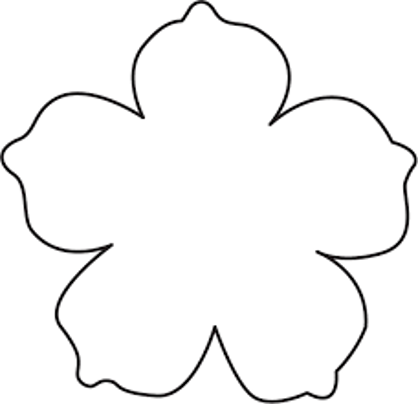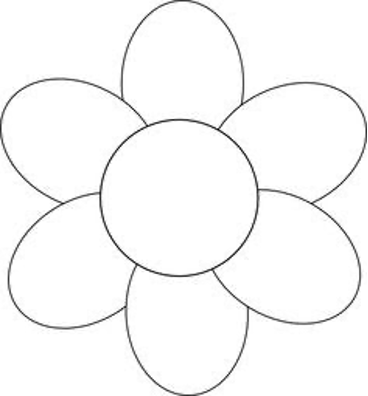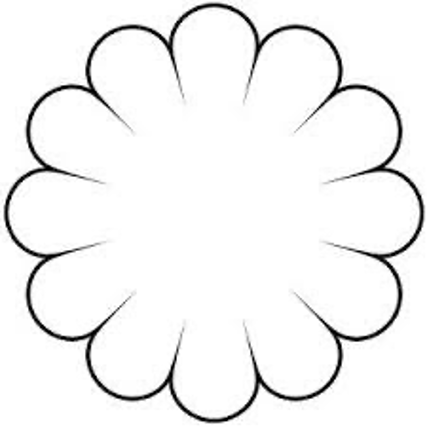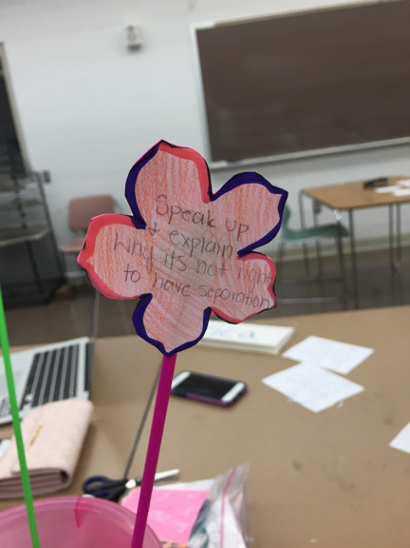Have You Filled a Bucket Today?
Compassion: Grade 1 lesson plan
- Lesson theme: Compassion
- Integrated subject: Language Arts
- Grade level: First grade
- Time: 30 minutes
- Lesson authors: Laura Atkins, Lindsay Spragg, and Madison Zurawski of Miami University of Ohio.
Lesson Overview
For this lesson, the students will be learning about the concept of compassion through learning about the events of Freedom Summer. The students will show that they understand the meaning of compassion by writing on a flower cut out how they are compassionate towards another student that is in a given photograph who appears to be suffering.
Essential Questions
- What does it mean to be compassionate?
- How can you demonstrate compassion towards others?
- What does compassion look like in your classroom?
Visual Culture Component
Compassion (video is blocked in our country)
This video helps kids learn how to implement compassion into their lives through a variety of examples. This can be used as an intro for students in a 1st grade classroom to connect the idea of compassion into their everyday lives. When the word compassion comes up, teachers can show this video to enhance the idea of compassion in a new way. Kids their age come up with examples of when they showed compassion for other people so this will illustrate to the class how they can give out compassion to others as well.
Discussion questions to ask students:
- When is a time that you may have shown compassion to someone?
- When has someone showed compassion on you?
Ohio Standards of Learning / Common Core
Ohio Visual Arts Standards met for 1st grade:
- (PE-1) Recognize and describe that people create art and art objects to communicate ideas and serve different purposes.
- (PR-1) Demonstrate beginning skill and craftsmanship in the use of art materials and tools.
- (RE-1) Recognize and point out the strengths in their artworks and how the work could be improved.
- PDF file: Ohio’s Learning Standards for Fine Arts: Visual Arts (April 2020 draft)
- Language Arts Standard: CCSS.ELA-LITERACY.L.1.5
- With guidance and support from adults, demonstrate understanding of word relationships and nuances in word meanings.
- CCSS.ELA-LITERACY.L.1.5.C: Identify real-life connections between words and their use (e.g., note places at home that are cozy).
- With guidance and support from adults, demonstrate understanding of word relationships and nuances in word meanings.
Lesson Objectives
Students will:
- Recognize and describe that people create art and art objects to communicate ideas and serve different purposes through identifying ways to be compassionate towards others on three flowers and filling the buckets, independently (PE-1).
- Demonstrate beginning skill and craftsmanship in the use of three different art materials and tools by drawing with pencil or crayon on a flower cut out, independently (PR-1).
- Recognize and point out the strengths in their artworks and list two ways how their work could be improved, independently (RE-1).
- Demonstrate understanding of word relationship and nuances in the word meanings of compassion, suffering, and inequality (CCSS.ELA-LITERACY.L.1.5)
- Identify real-life connections between compassion, suffering, and inequality and their use (CCSS.ELA-LITERACY.L.1.5.C).
Vocabulary / Academic Language:
Language Arts Vocabulary:
- Compassion:
- Understanding how another person feels
- Caring about others
- Showing concern through kind thoughts, words, and actions
- Helping and giving
- Listening and being patient
- Sorry or pity caused by the suffering or misfortune
- Suffering:
- State of undergoing pain, distress or hardship
- To experience something unpleasant
- To become worse because of being badly affected by something
- Experiencing being sad or not happy because of your circumstances
- To feel or endure pain
- To bear loss or damage
- Inequality:
- The quality of being unequal
- When a person or group of people are not treated fairly
For more resources on teaching tolerance, visit the Teaching Tolerance website.
Art Vocabulary:
- Shape/Form
- Outer part of an object-think about circles, squares, triangles
- Color
- Red, yellow, blue, or a mixture of these colors together that we see everywhere we go
- Texture
- How something feels either by touching it or by thinking about what it feels like through looking at it
Historical/Cultural/Artist Information
- Summary for students:
- Discuss what equality means with students (ask group what their thoughts are).
- Some people in the United States thought that white people were better than black people, which is not true. We are all equal.
- Black people wanted to be able to vote in Mississippi.
- A group of black and white people came together to show that everyone could be equal and be trained to stand up for what was right–this is called the “Freedom Summer” – the training for volunteers took place in Oxford, Ohio in 1964. This was part of the Civil Rights movement.
- In the training, volunteers were not learning to hurt other people, they were learning how to “defend” themselves if someone were to hurt them.
- People who were not being affected by these events wanted to help out, they were showing “compassion” to other people by putting their self in others’ shoes to understand how they may have felt.
Image Descriptions:
Image Credit: Peter Bregg
PhotoSensitive’s first project. A photo essay on Toronto’s hungry, homeless and the triumph of the human spirit. It’s in Their Eyes was exhibited in 1992. Gerard Kennedy, now an MP in Ottawa, was running the Daily Bread Food Bank in 1990 and he knew right away that the PhotoSensitive group was something extraordinary. Several photographs were taken at the Daily Bread Food Bank, which was the project’s principle beneficiary. The photographs drew attention to the plight of the city’s disadvantaged, their determination, camaraderie and their yearning for dignity. Photographs don’t feed children the show’s brochure said. We offer this in hope that one less child goes hungry tomorrow.




Questions about the Pictures:
- How are these kids suffering?
- How are these kids experiencing inequality?
- How can you show these kids compassion?
Lesson Procedures:
Fill Other’s Buckets
- Visual Cultural Component:
- This video (Compassion) helps kids learn how to implement compassion into their lives through a variety of examples. This can be used as an introduction for students in a 1st grade classroom to connect the idea of compassion into their everyday lives before beginning the lesson. When the word compassion comes up, teachers can show this video to enhance the idea of compassion in a new way so students have a better understanding. Kids their age (1st grade) come up with examples of when they showed compassion for other people so this will illustrate to the class how they can show compassion to others as well. This will get their minds prepared for the day’s lesson of “filling other’s buckets.”
- Discussion questions to ask students:
- When is a time that you may have shown compassion to someone?
- When has someone showed compassion on you?
- Discussion questions to ask students:
- This video (Compassion) helps kids learn how to implement compassion into their lives through a variety of examples. This can be used as an introduction for students in a 1st grade classroom to connect the idea of compassion into their everyday lives before beginning the lesson. When the word compassion comes up, teachers can show this video to enhance the idea of compassion in a new way so students have a better understanding. Kids their age (1st grade) come up with examples of when they showed compassion for other people so this will illustrate to the class how they can show compassion to others as well. This will get their minds prepared for the day’s lesson of “filling other’s buckets.”
- Opening: Read aloud of the book Have you filled a bucket today? By Carol McCloud.
- Explain during the opening how everyone has differences but it is important to recognize these differences in a positive way.
- “Today we are going to be filling people’s buckets that we may not know so first we are going to be giving you some information about these people! Similar to how the students in the book are filling each other’s buckets in the book with kind words, we are actually going to be filling buckets that are placed all around the room. You can fill someone’s bucket without actually having a bucket but just simply through saying nice things to him or her. Make sure to use your listening ears so that when it comes time for the activity you know what to do!”
- What is one way you could fill someone’s bucket in the classroom?
- Teaching about Freedom Summer: Before you were all born, there was something that happened in Mississippi (volunteers were trained in Oxford, Ohio) that has changed the way the world works today. This event was called “Freedom Summer” and was part of the Civil Rights movement. Back then not everyone was treated equal. We know that you know that everyone deserves to be treated the way they want to be treated (golden rule). *See historical/cultural information for more details on how to explain Freedom Summer to first graders.
- Activity: There will be different pictures of children from around the world posted around the classroom. There will be 4 buckets in total placed around the room. These buckets will then be placed under each one of the photographs. The students will then be given a piece of paper in the shape of a flower to write down ways they can show compassion to the students that were not treated equally. On these flowers, students will write encouraging notes that show compassion towards the students in the pictures.
- In this section: go over the art vocabulary words that we have listed above (shape/form, color and texture) when explaining how to decorate the flowers.
- Teacher Modeling: The teacher will get a separate bucket and will have a picture to model how to do the art portion of this lesson. Then the teacher will write down an example of what they could write on the flower to then will tape them to one of the skewers that are place in the buckets.
- Guided Practice: The teacher would then brainstorm with the class something else that they could write to show compassion to the children in the picture. Then two students would come up to the front of the class and write two different ways to show compassion on flowers then will tape them to one of the skewers that are place in the bucket.
- Independent: The students will be given outlines of flowers on paper to decorate and write down ways to be compassionate towards the children in the photos. The students will place the flowers in the corresponding bucket by taping them to one of the skewers that are place in the buckets. They will have to at least fill three of the buckets.
- Ending:
- What does it mean to be compassionate?
- How can you demonstrate compassion towards others?
- What does compassion look like in your classroom?
Evaluation:
You (the student):
- Recognized and described that people create art and art objects to communicate ideas and serve different purposes through identifying ways to be compassionate towards others on three flowers and filling the buckets, independently (PE-1).
- Demonstrated beginning skill and craftsmanship in the use of three different art materials and tools by drawing with pencil or crayon on a flower cut out, independently (PR-1).
- Recognized and pointed out the strengths in their artworks and listed two ways how their work could be improved, independently (RE-1).
- Demonstrated understanding of word relationship and nuances in the word meanings of compassion, suffering, and inequality (CCSS.ELA-LITERACY.L.1.5)
- Identified real-life connections between compassion, suffering, and inequality and their use (CCSS.ELA-LITERACY.L.1.5.C).
Materials and Preparation:
- Online book, Have you filled a bucket today? By, Carol McCloud
- Different types of buckets (we must have compassion for ALL people)
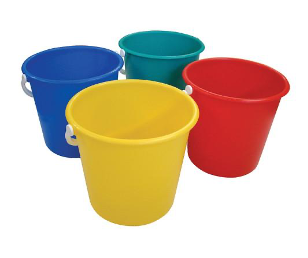
- Images of children or students are available for students in the classroom to see how they can be compassionate towards others
- Students have flower cut out to decorate and write how they will fill other people’s buckets
- Utensils (crayons, pencils) for students to write with (a bag filled with utensils for each table)
- Markers, Magazines and newspapers to decorate the flowers (anything that you have available)
- Colored construction paper to put on the back of flowers to keep them sturdy
- Styrofoam to place at the bottom of each bucket
- Skewers (about 10 per bucket) to place in the styrofoam to attach the flowers to


Resources:
- Ohio Visual Arts Standards
- Language Arts Common Core Standard
- Freedom Summer Digital Archive
- Powerpoint for Lesson


